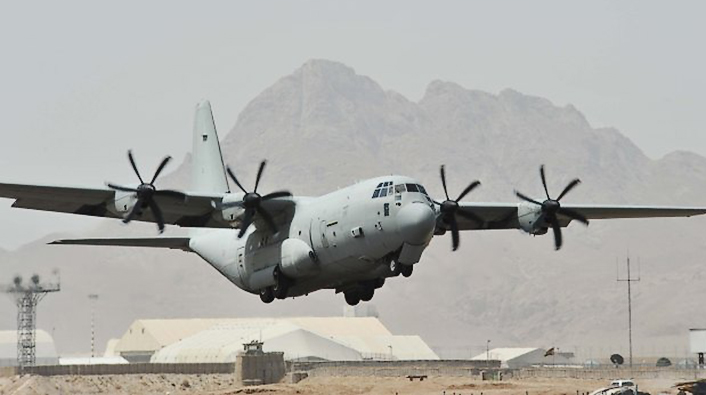The Italian Air Force C-130J performed evasive maneuvers but it was not being targeted by small arms fire.
Several Italian media outlets reported that a C-130J aircraft of the Aeronautica Militare (Italian Air Force) was shot at moments taking off from Kabul, on Aug. 26, 2021.
The aircraft had taken off for an evacuation mission from Afghanistan, with about 100 Afghan refugees and a group of journalists when the evasive maneuvers performed by the aircrew created some confusion and concern among the passengers.
“A few minutes had passed since take-off, then, suddenly the plane started to maneuver off the original route. Those on board understood that something was wrong. And so, after leaving the soil of Kabul, there were moments of panic inside the C-130 of the Italian Air Force targeted by gunshots,” the Italian Il Giornale newspaper reported. The same
“The aircraft had to carry out evasive maneuvers minutes after take-off, for shots fired at the aircraft from the ground,” SkyTG24 reporter who was aboard the Italian Super Hercules said.
However, the aircraft was not targeted by Taliban fire.
According to what has been learned from intelligence sources, an Afghan pickup equipped with machine guns and located away from the runway, fired a few 14.5 caliber machine gun shots straight up to disperse the crowd pressing towards the gate of the Kabul International Airport. Tracers coming from the ground were spotted by the pilot of the C-130 (flying at 4,000 feet) who, according to the procedures, carried out the evasive maneuvers that scared all the passengers in the Super Hercules. The C-130J, one of the five involved in Operation “Aquila Omnia” then continued its mission and safely landed at Al Salem Air Base in Kuwait.
The fact that the aircraft was not trying to evade a direct attack obviously does not mean taking off or landing at Kabul is anyhow safe. There’s a lot of people all around the perimeter fence (if not inside the airport) and the danger posed by RPG, small arms fire (or even MANPADS) from the vicinity of the airport is pretty high. For this reason, aircraft departing Kabul perform evasive maneuvers or release flares as a precautionary procedure against the threat of infrared guides missiles
French Air Force A400M dispensing flares as it departs #Kabul Airport #Afghanistan
pic.twitter.com/9C2UM9BcwO
— Intel Air & Sea (@air_intel) August 21, 2021
The “incident” involving the Italian aircraft occurred few hours before a terrorist attack hit Hamid Karzai International Airport in Kabul, killing 60 people (and, reportedly, at least 12 U.S. service members).
Today, 551 people were evacuated from Kabul aboard the C-130J of the Italian Air Force. As explained, the civilians are carried to Kuwait and from there transferred to Italy by means of larger KC-767s.
This is what we wrote about the Italian air bridge to evacuate civilians from Afghanistan put in place by the Italian MOD in our extensive report on “Aquila Omnia” that you can find here:
Speaking about the serials, for the KC-767s there are MM62229/14-04, MM62226/14-01 and MM62227/14-02, while for the C-130 there is a single standard J model MM62178/46-43 and three of the longer J-30 model (the fuselage is 15 feet longer than the J, increasing the cargo space) MM62195/46-61, MM62194/46-60 and MM62189/46-55. As an interesting side note, it appears that none of the Italian C-130s wears its serial number as it was seemingly painted over, leaving only the two letters MM (Matricola Militare/ Military Serial) without the actual number.
Once in Kabul, the C-130s load about 100 people per flight after they have been checked and identified by Italian troops, which were deployed to the airport before the beginning of the evacuation. According to some sources, each aircraft can only stay on the ground for about 30 minutes, as there is not enough free space on the airport ramps for everyone to land. Kabul is the only airport still operational in Afghanistan, so this kind of timing is needed to grant every aircraft enough space to safely land, load the personnel and depart again.
After leaving Kabul, the C-130s land at an unspecified location for a technical stop to refuel and then fly back to Kuwait. Once there, the passengers of the C-130s are transferred on the KC-767 that will take them to Rome Fiumicino airport in Italy, where they are screened to check if there is anyone in need of medical assistance and then transferred in a safe location. The Italian Army granted the use of some of its barracks for this, where the Afghans will be assisted while waiting for resettlement in Italy.
The Italian crews are flying day and night in and out of Kabul, with the MoD providing regular updates about the operation. As mentioned in the official statements, there are about four C-130J flights each day, now that the evacuation is in full swing, followed by at least two KC-767 flights to Italy. The difference in the number of flights is obviously due to the different capacity of the two aircraft types, with the KC-767 transporting up to 200 passengers in the full pax configuration and the C-130J and C-130J-30 transporting up to 92 and 128 passengers respectively.
4,898 people (including 4,832 Afghan citizens) have been evacuated from Kabul, since Italy started transferring civilians out of Afghanistan. At the moment 4,575 (including 1,062 women and 1,146 children) have already arrived in Italy.









